2017 NISSAN LEAF steering wheel
[x] Cancel search: steering wheelPage 348 of 424
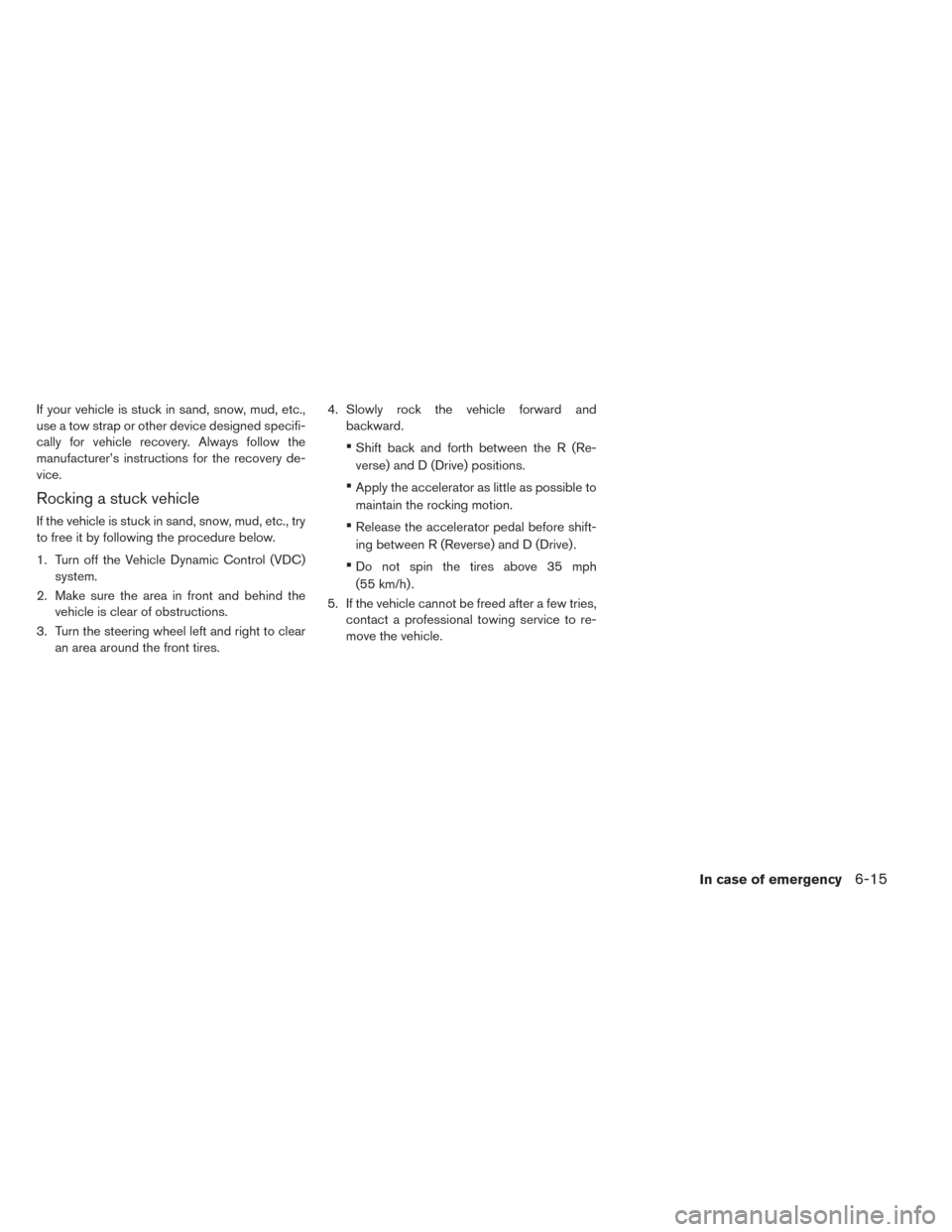
If your vehicle is stuck in sand, snow, mud, etc.,
use a tow strap or other device designed specifi-
cally for vehicle recovery. Always follow the
manufacturer’s instructions for the recovery de-
vice.
Rocking a stuck vehicle
If the vehicle is stuck in sand, snow, mud, etc., try
to free it by following the procedure below.
1. Turn off the Vehicle Dynamic Control (VDC)system.
2. Make sure the area in front and behind the vehicle is clear of obstructions.
3. Turn the steering wheel left and right to clear an area around the front tires. 4. Slowly rock the vehicle forward and
backward.
•Shift back and forth between the R (Re-
verse) and D (Drive) positions.
•Apply the accelerator as little as possible to
maintain the rocking motion.
•Release the accelerator pedal before shift-
ing between R (Reverse) and D (Drive) .
•Do not spin the tires above 35 mph
(55 km/h) .
5. If the vehicle cannot be freed after a few tries, contact a professional towing service to re-
move the vehicle.
In case of emergency6-15
Page 360 of 424
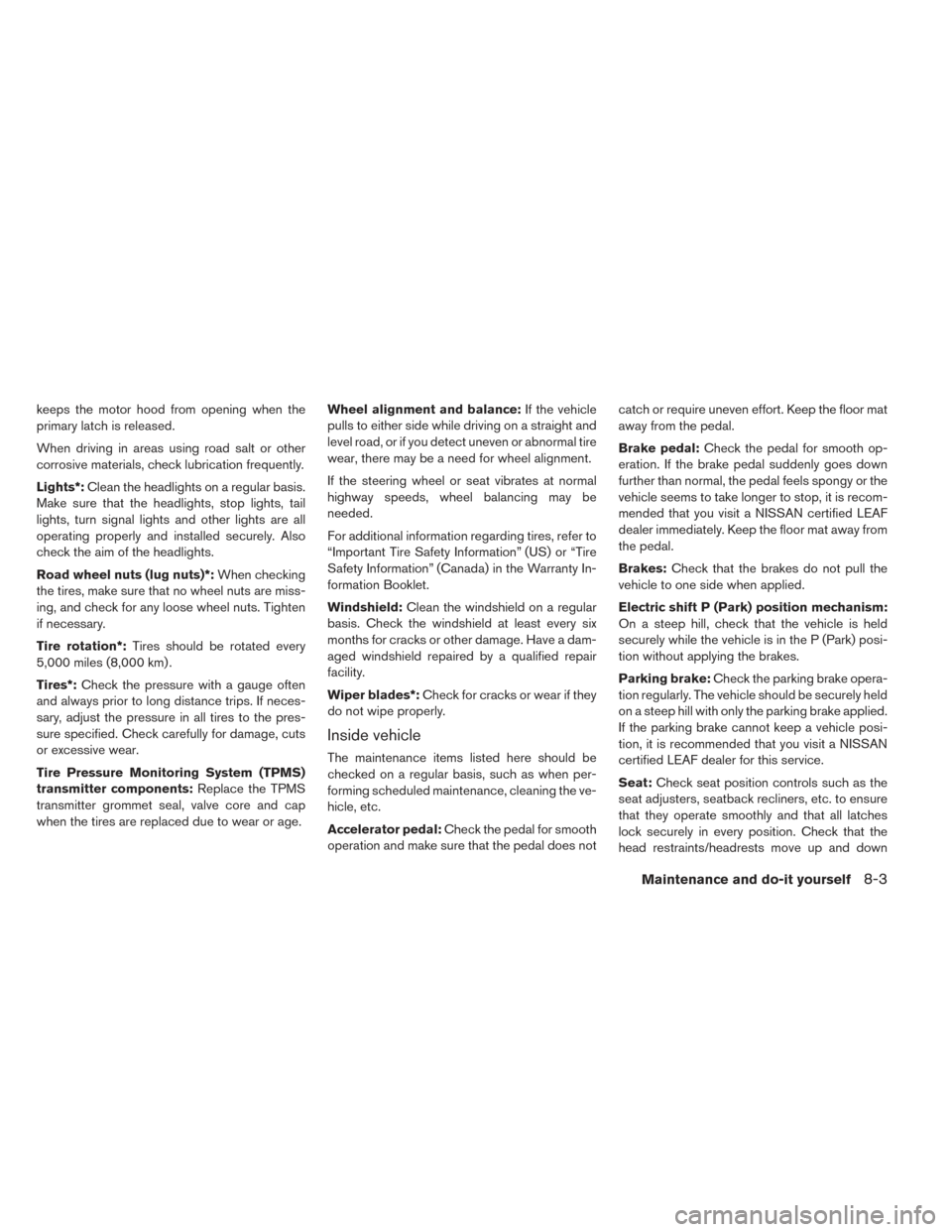
keeps the motor hood from opening when the
primary latch is released.
When driving in areas using road salt or other
corrosive materials, check lubrication frequently.
Lights*:Clean the headlights on a regular basis.
Make sure that the headlights, stop lights, tail
lights, turn signal lights and other lights are all
operating properly and installed securely. Also
check the aim of the headlights.
Road wheel nuts (lug nuts)*: When checking
the tires, make sure that no wheel nuts are miss-
ing, and check for any loose wheel nuts. Tighten
if necessary.
Tire rotation*: Tires should be rotated every
5,000 miles (8,000 km) .
Tires*: Check the pressure with a gauge often
and always prior to long distance trips. If neces-
sary, adjust the pressure in all tires to the pres-
sure specified. Check carefully for damage, cuts
or excessive wear.
Tire Pressure Monitoring System (TPMS)
transmitter components: Replace the TPMS
transmitter grommet seal, valve core and cap
when the tires are replaced due to wear or age. Wheel alignment and balance:
If the vehicle
pulls to either side while driving on a straight and
level road, or if you detect uneven or abnormal tire
wear, there may be a need for wheel alignment.
If the steering wheel or seat vibrates at normal
highway speeds, wheel balancing may be
needed.
For additional information regarding tires, refer to
“Important Tire Safety Information” (US) or “Tire
Safety Information” (Canada) in the Warranty In-
formation Booklet.
Windshield: Clean the windshield on a regular
basis. Check the windshield at least every six
months for cracks or other damage. Have a dam-
aged windshield repaired by a qualified repair
facility.
Wiper blades*: Check for cracks or wear if they
do not wipe properly.
Inside vehicle
The maintenance items listed here should be
checked on a regular basis, such as when per-
forming scheduled maintenance, cleaning the ve-
hicle, etc.
Accelerator pedal: Check the pedal for smooth
operation and make sure that the pedal does not catch or require uneven effort. Keep the floor mat
away from the pedal.
Brake pedal:
Check the pedal for smooth op-
eration. If the brake pedal suddenly goes down
further than normal, the pedal feels spongy or the
vehicle seems to take longer to stop, it is recom-
mended that you visit a NISSAN certified LEAF
dealer immediately. Keep the floor mat away from
the pedal.
Brakes: Check that the brakes do not pull the
vehicle to one side when applied.
Electric shift P (Park) position mechanism:
On a steep hill, check that the vehicle is held
securely while the vehicle is in the P (Park) posi-
tion without applying the brakes.
Parking brake: Check the parking brake opera-
tion regularly. The vehicle should be securely held
on a steep hill with only the parking brake applied.
If the parking brake cannot keep a vehicle posi-
tion, it is recommended that you visit a NISSAN
certified LEAF dealer for this service.
Seat: Check seat position controls such as the
seat adjusters, seatback recliners, etc. to ensure
that they operate smoothly and that all latches
lock securely in every position. Check that the
head restraints/headrests move up and down
Maintenance and do-it yourself8-3
Page 361 of 424
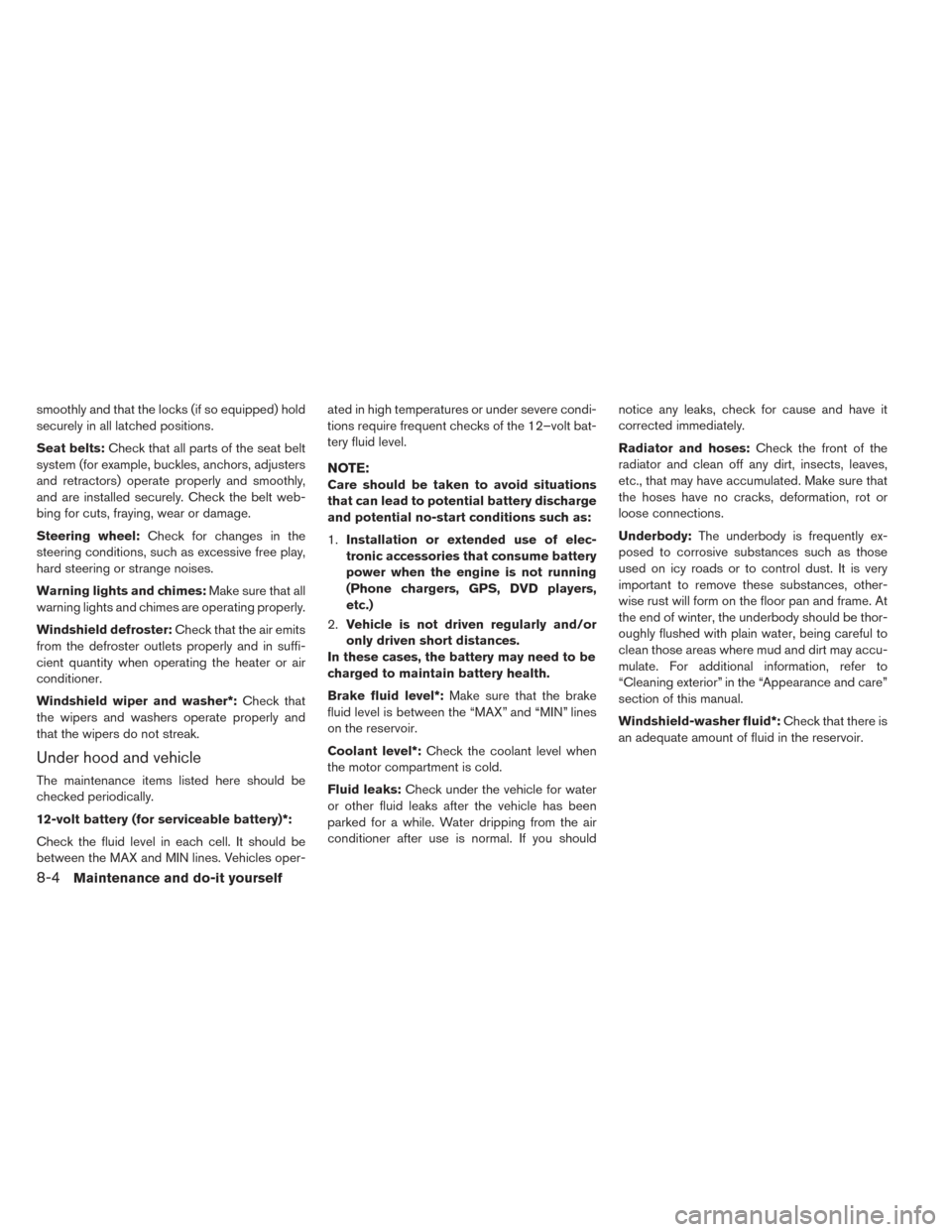
smoothly and that the locks (if so equipped) hold
securely in all latched positions.
Seat belts:Check that all parts of the seat belt
system (for example, buckles, anchors, adjusters
and retractors) operate properly and smoothly,
and are installed securely. Check the belt web-
bing for cuts, fraying, wear or damage.
Steering wheel: Check for changes in the
steering conditions, such as excessive free play,
hard steering or strange noises.
Warning lights and chimes: Make sure that all
warning lights and chimes are operating properly.
Windshield defroster: Check that the air emits
from the defroster outlets properly and in suffi-
cient quantity when operating the heater or air
conditioner.
Windshield wiper and washer*: Check that
the wipers and washers operate properly and
that the wipers do not streak.
Under hood and vehicle
The maintenance items listed here should be
checked periodically.
12-volt battery (for serviceable battery)*:
Check the fluid level in each cell. It should be
between the MAX and MIN lines. Vehicles oper- ated in high temperatures or under severe condi-
tions require frequent checks of the 12–volt bat-
tery fluid level.
NOTE:
Care should be taken to avoid situations
that can lead to potential battery discharge
and potential no-start conditions such as:
1.
Installation or extended use of elec-
tronic accessories that consume battery
power when the engine is not running
(Phone chargers, GPS, DVD players,
etc.)
2. Vehicle is not driven regularly and/or
only driven short distances.
In these cases, the battery may need to be
charged to maintain battery health.
Brake fluid level*: Make sure that the brake
fluid level is between the “MAX” and “MIN” lines
on the reservoir.
Coolant level*: Check the coolant level when
the motor compartment is cold.
Fluid leaks: Check under the vehicle for water
or other fluid leaks after the vehicle has been
parked for a while. Water dripping from the air
conditioner after use is normal. If you should notice any leaks, check for cause and have it
corrected immediately.
Radiator and hoses:
Check the front of the
radiator and clean off any dirt, insects, leaves,
etc., that may have accumulated. Make sure that
the hoses have no cracks, deformation, rot or
loose connections.
Underbody: The underbody is frequently ex-
posed to corrosive substances such as those
used on icy roads or to control dust. It is very
important to remove these substances, other-
wise rust will form on the floor pan and frame. At
the end of winter, the underbody should be thor-
oughly flushed with plain water, being careful to
clean those areas where mud and dirt may accu-
mulate. For additional information, refer to
“Cleaning exterior” in the “Appearance and care”
section of this manual.
Windshield-washer fluid*: Check that there is
an adequate amount of fluid in the reservoir.
8-4Maintenance and do-it yourself
Page 418 of 424
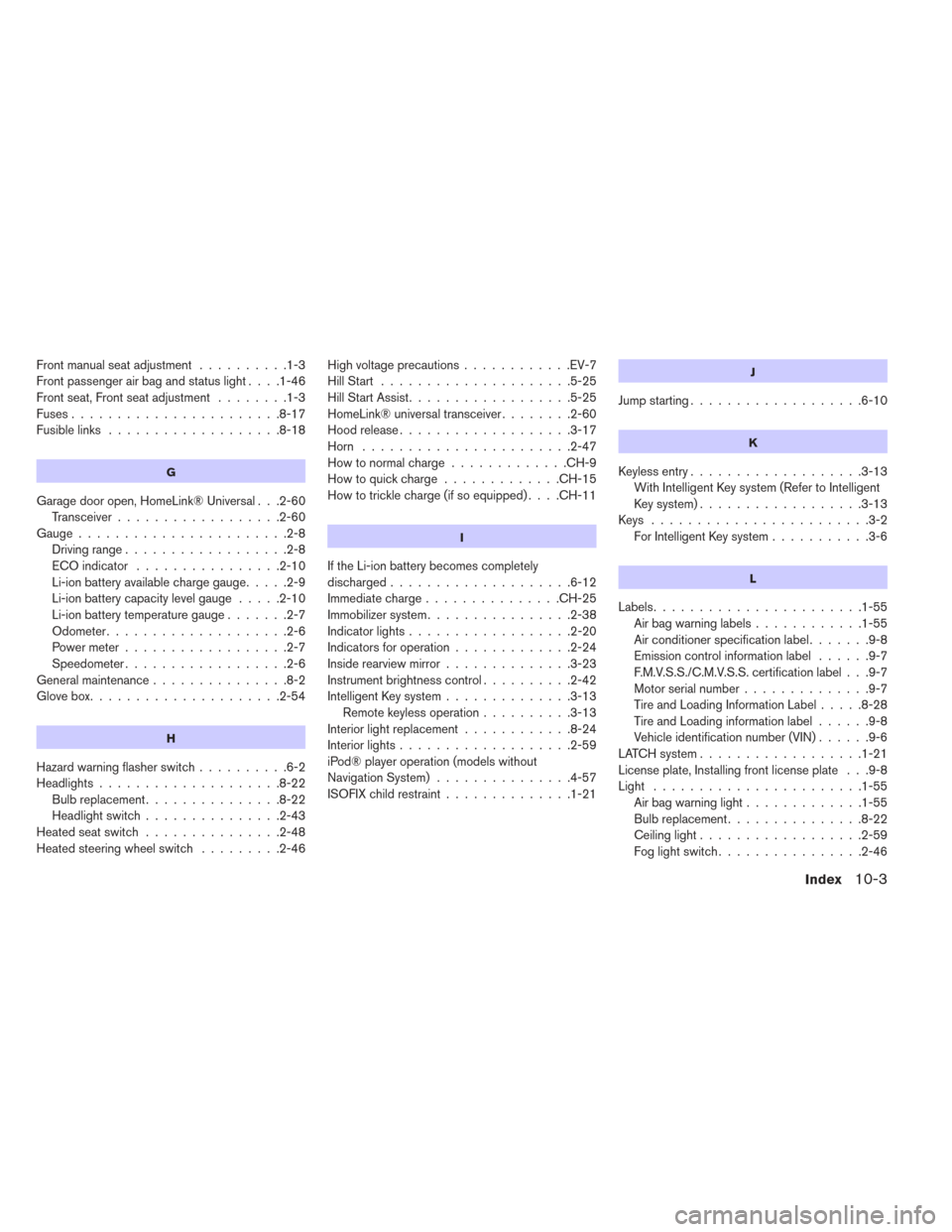
Front manual seat adjustment..........1-3
Front passenger air bag and status light ....1-46
Front seat, Front seat adjustment ........1-3
Fuses.......................8-17
Fusiblelinks ...................8-18
G
Garage door open, HomeLink® Universal . . .2-60 Transceiver ..................2-60
Gauge.......................2-8 Driving range ..................2-8
ECOindicator ................2-10
Li-ion battery available charge gauge .....2-9
Li-ion battery capacity level gauge .....2-10
Li-ion battery temperature gauge .......2-7
Odometer ....................2-6
Power meter ..................2-7
Speedometer ..................2-6
Generalmaintenance...............8-2
Glovebox.....................2-54
H
Hazard warning flasher switch ..........6-2
Headlights ....................8-22
Bulb replacement ...............8-22
Headlightswitch...............2-43
Heatedseatswitch ...............2-48
Heated steering wheel switch .........2-46Highvoltageprecautions............EV-7
HillStart .....................5-25
Hill Start Assist
..................5-25
HomeLink® universal transceiver ........2-60
Hood release ...................3-17
Horn .......................2-47
How to normal charge .............CH-9
How to quick charge .............CH-15
How to trickle charge (if so equipped) ....CH-11
I
If the Li-ion battery becomes completely
discharged....................6-12
Immediate charge ...............CH-25
Immobilizer system ................2-38
Indicatorlights..................2-20
Indicators for operation .............2-24
Inside rearview mirror ..............3-23
Instrument brightness control ..........2-42
Intelligent Key system ..............3-13
Remote keyless operation ..........3-13
Interior light replacement ............8-24
Interior lights ...................2-59
iPod® player operation (models without
Navigation System) ...............4-57
ISOFIX child restraint ..............1-21
J
Jump starting...................6-10
K
Keyless entry...................3-13
With Intelligent Key system (Refer to Intelligent
Key system) ..................3-13
Keys ........................3-2 For Intelligent Key system ...........3-6
L
Labels.......................1-55
Airbagwarninglabels............1-55
Air conditioner specification label .......9-8
Emission control information label ......9-7
F.M.V.S.S./C.M.V.S.S. certification label . . .9-7
Motor serial number ..............9-7
Tire and Loading Information Label .....8-28
Tire and Loading information label ......9-8
Vehicle identification number (VIN) ......9-6
LATCH system ..................1-21
License plate, Installing front license plate . . .9-8
Light .......................1-55 Airbagwarninglight.............1-55
Bulb replacement ...............8-22
Ceiling light ..................2-59
Fog light switch ................2-46
Index10-3
Page 421 of 424
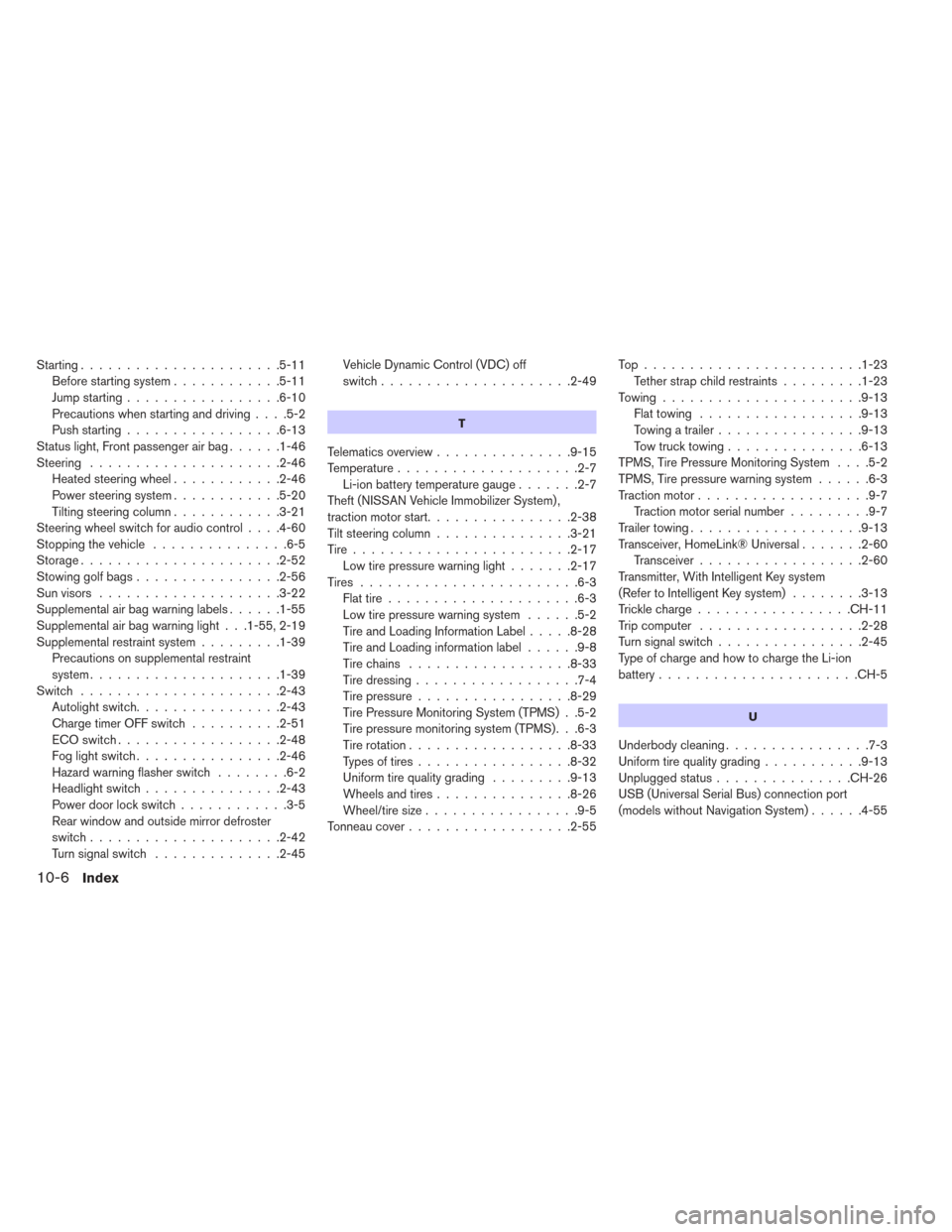
Starting......................5-11
Before starting system ............5-11
Jump starting .................6-10
Precautions when starting and driving ....5-2
Push starting .................6-13
Status light, Front passenger air bag ......1-46
Steering .....................2-46 Heated steering wheel ............2-46
Power steering system ............5-20
Tilting steering column ............3-21
Steering wheel switch for audio control ....4-60
Stoppingthevehicle ...............6-5
Storage......................2-52
Stowing golf bags ................2-56
Sun visors ....................3-22
Supplemental air bag warning labels ......1-55
Supplemental air bag warning light . . .1-55, 2-19
Supplemental restraint system .........1-39
Precautions on supplemental restraint
system.....................1-39
Switch ......................2-43
Autolightswitch................2-43
ChargetimerOFFswitch ..........2-51
ECOswitch..................2-48
Foglightswitch................2-46
Hazard warning flasher switch ........6-2
Headlightswitch...............2-43
Power door lock switch ............3-5
Rear window and outside mirror defroster
switch.....................2-42
Turnsignalswitch ..............2-45 Vehicle Dynamic Control (VDC) off
switch.....................2-49
T
Telematics overview
...............9-15
Temperature ....................2-7
Li-ion battery temperature gauge .......2-7
Theft (NISSAN Vehicle Immobilizer System) ,
traction motor start ................2-38
Tilt steering column ...............3-21
Tire........................2-17 Low tire pressure warning light .......2-17
Tires ........................6-3 Flat tire .....................6-3
Low tire pressure warning system ......5-2
Tire and Loading Information Label .....8-28
Tire and Loading information label ......9-8
Tirechains ..................8-33
Tire dressing ..................7-4
Tire pressure .................8-29
Tire Pressure Monitoring System (TPMS) . .5-2
Tire pressure monitoring system (TPMS). . .6-3
Tire rotation ..................8-33
Types of tires .................8-32
Uniform tire quality grading .........9-13
Wheels and tires ...............8-26
Wheel/tire size .................9-5
Tonneau cover ..................2-55 Top........................1-23
Tether strap child restraints .........1-23
Towing......................9-13 Flattowing ..................9-13
Towing a trailer ................9-13
Towtrucktowing...............6-13
TPMS, Tire Pressure Monitoring System ....5-2
TPMS, Tire pressure warning system ......6-3
Traction motor ...................9-7
Traction motor serial number .........9-7
Trailer towing ...................9-13
Transceiver, HomeLink® Universal .......2-60
Transceiver ..................2-60
Transmitter, With Intelligent Key system
(Refer to Intelligent Key system) ........3-13
Trickle charge .................CH-11
Trip computer ..................2-28
Turn signal switch ................2-45
Type of charge and how to charge the Li-ion
battery ......................CH-5
U
Underbody cleaning ................7-3
Uniform tire quality grading ...........9-13
Unplugged status ...............CH-26
USB (Universal Serial Bus) connection port
(models without Navigation System) ......4-55
10-6Index